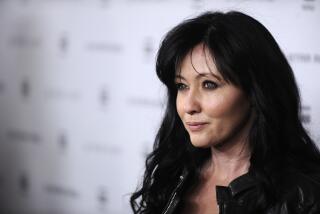The life force of S. Epatha Merkerson
“Law & Order’s” S. Epatha Merkerson does not get the good lines.
She is not one of the show’s leads.
And except in a very, very rare while, she does not get the spotlight.
Yet, after 16 years and nearly 400 episodes, Merkerson and her character, Lt. Anita Van Buren, are two of the most valuable assets the once unbreakable show has ever had.
“The first thing you see about her is the raw talent on the screen,” says “L&O” show runner Rene Balcer. “The second thing is her tremendous work habits. She communicates so much sometimes by saying so little. There’s just this tremendous life force in her.”
And perhaps a good sense of timing as well. Merkerson announced that she was leaving the show just weeks before NBC decided not to renew it for a 21st season. Regardless of the network decision, and any eleventh-hour changes of heart it might have, S. Epatha Merkerson (the “S” once stood for “Sharon” and now legally stands for nothing) is taking Van Buren and her life force and exiting the show. She’ll end her run as the (likely) longest-running actress ever to appear on a TV series (“Gunsmoke’s” Amanda Blake had more episodes as Miss Kitty, but many of those were on half-hour episodes). There was no acrimony involved in the decision; Merkerson says it was just time to move on.
And, as it happens, it was just as the spotlight finally was swinging in her direction. This season, Balcer and his writing staff gave her a story arc with a little substance: Van Buren was diagnosed with cervical cancer.
“The thing is, I’ve always said, ‘I’m here, use me,’” says the Detroit-born actress, who can count two Tony nominations and a Golden Globe and an Emmy (both for HBO’s “Lackawanna Blues”) among her list of accolades. “It just occurred to me that this is the perfect story to finish this character.”
For more than a decade and a half, Van Buren’s primary role has been to support, protect and defend the various detectives at the 27th Precinct. She has had a few moments dedicated to her — in 1994, the character shot a mentally disabled young man during a robbery, and the episode “Competence” revolved around the incident and Van Buren’s involvement. But since then, even her B stories have been dim — she’s been denied advancement on the force and fought to get her computer repaired.
“Sometimes we have overlooked her, to our detriment,” admits Balcer. “It’s a thankless role for actors, being the pivot in our first half, yet she’s been able to imbue it with such moral authority that you can’t help but notice her.”
Producers first noticed her in 1991, when she guest-starred in the series’ 17th episode, “Mushrooms,” as the mother of a boy who was accidentally shot. At the time, she was appearing on Broadway in “The Piano Lesson” and was called in after one of the show’s executive producers saw the play. She’d never seen the show but had someone tape it for her.
“I became a huge fan,” she says. “The theme music — this was really funky! And then it was an episode where [the prosecutor] lost a case he never should have lost, and I thought, ‘Wow, this is so close to the truth: The good guys don’t always win.”
Her “deep, authentic performance” in that episode impressed producers, and when more women were required by network edict in 1993, Merkerson came back full time. By then, her résumé included “Pee-Wee’s Playhouse” and small roles in such films as “Jacob’s Ladder” and “Terminator 2: Judgment Day.”
She immediately took to the character, shaping her not just with attitude but hairstyle. Merkerson’s hair (at least until the cancer story) had been a series of short “twist and lock” braids, but that was never going to be Van Buren’s style. So she put on a wig.
“I was always natural; Van Buren was always coiffed,” she explains. “After a while, they said, ‘Take the wig off,’ and I said, ‘No, Van Buren is one of the sisters who goes to the beauty parlor.’”
Initially, Van Buren’s nurturing Earth mother role concerned Merkerson, but in the ensuing years she’s learned how to look beyond that simplistic characterization.
“Black women are always used that way; it’s part of our history in the business,” she says. “How we get away from it, how it’s used and misused depends on what you’re working on. Here, it became something that was a positive for Van Buren — when there’s a young woman who needs to talk, immediately you’re comfortable around [Anita]. In that sense, it has been wisely used.”
Working within the limitations of a small character’s role, Merkerson has made Van Buren more than the sum of her parts. And what might turn out to be the biggest surprise for those who haven’t worked with Merkerson is that she’s much looser around the office than the lieutenant she plays.
“She has a big, broad way of talking, full of low-down language and colorful expression,” says Sam Waterston, who’s been a cast member almost as long as Merkerson. “All that sure helps with getting through the long hours of shooting.”
Among the many things the cast and crew will miss about the show will be Merkerson’s expansive personality. She’s off next to work on a documentary “about African American benevolent societies,” she says. That means they’ll never again get to hear her colorfully blue greeting when she walks on the set.
“It’s a term of endearment!” she says of the language more often used as an insult. “When I don’t cuss, that’s when you know I’m serious.”


